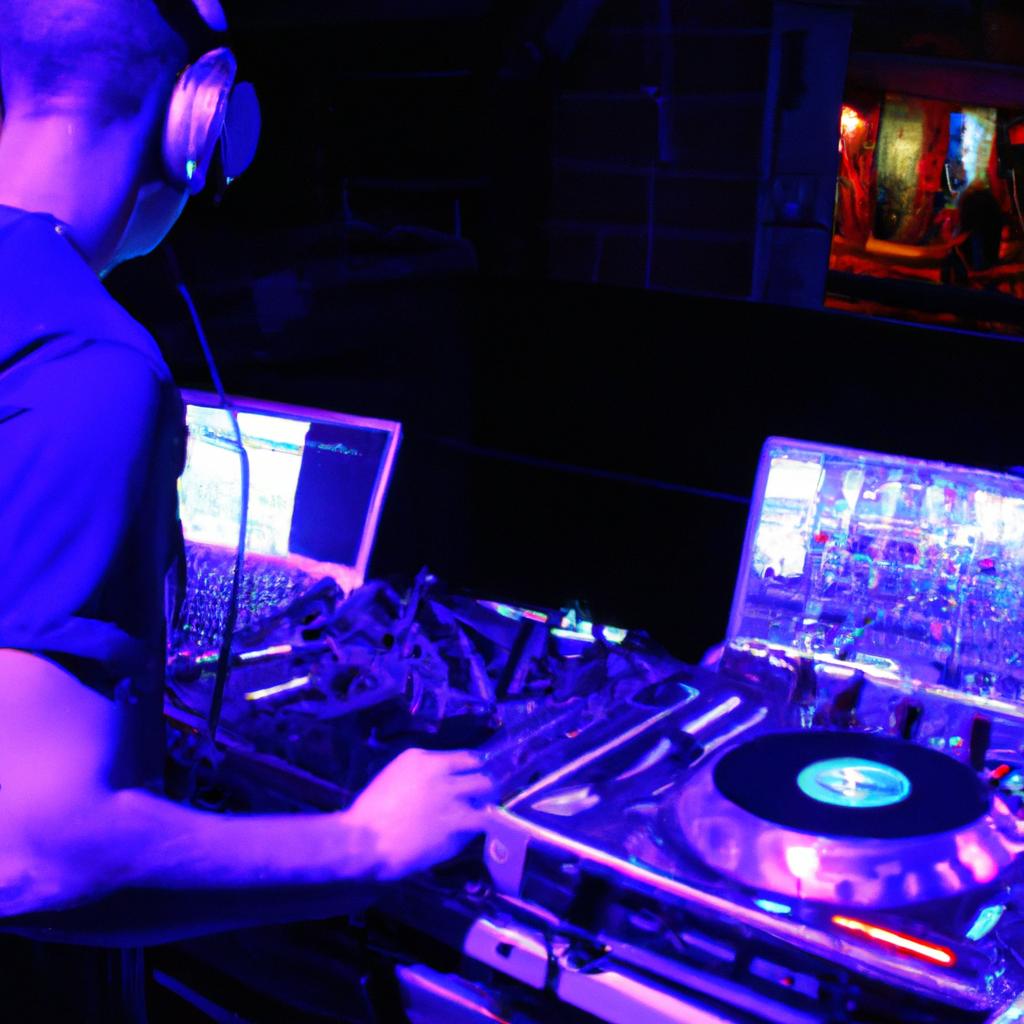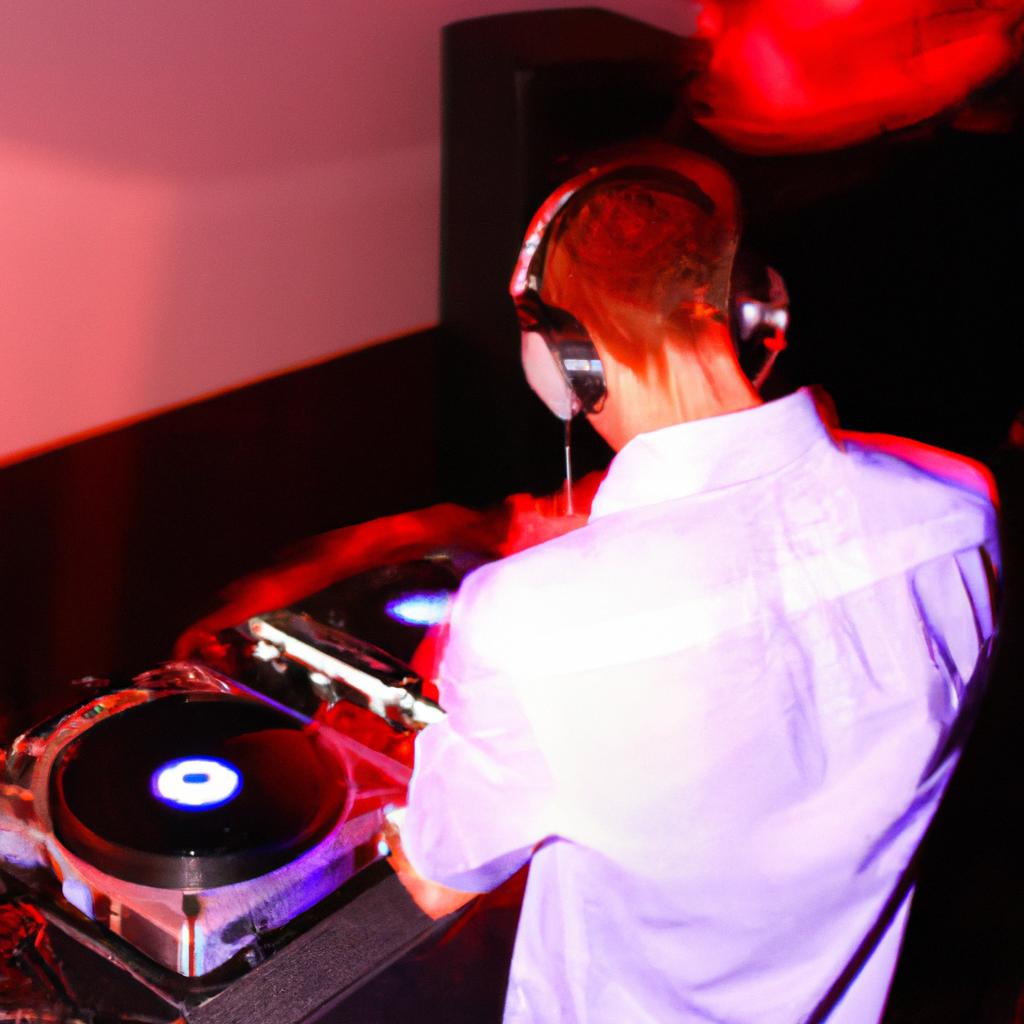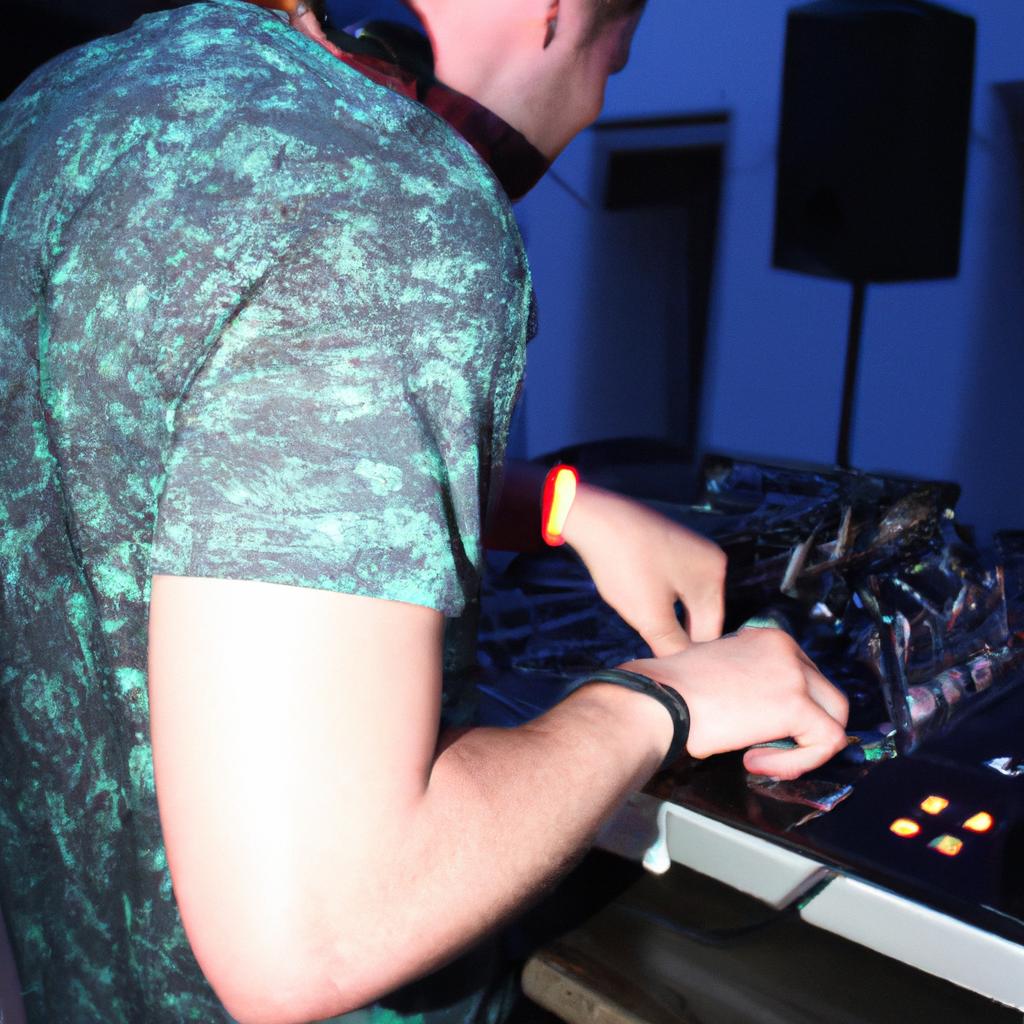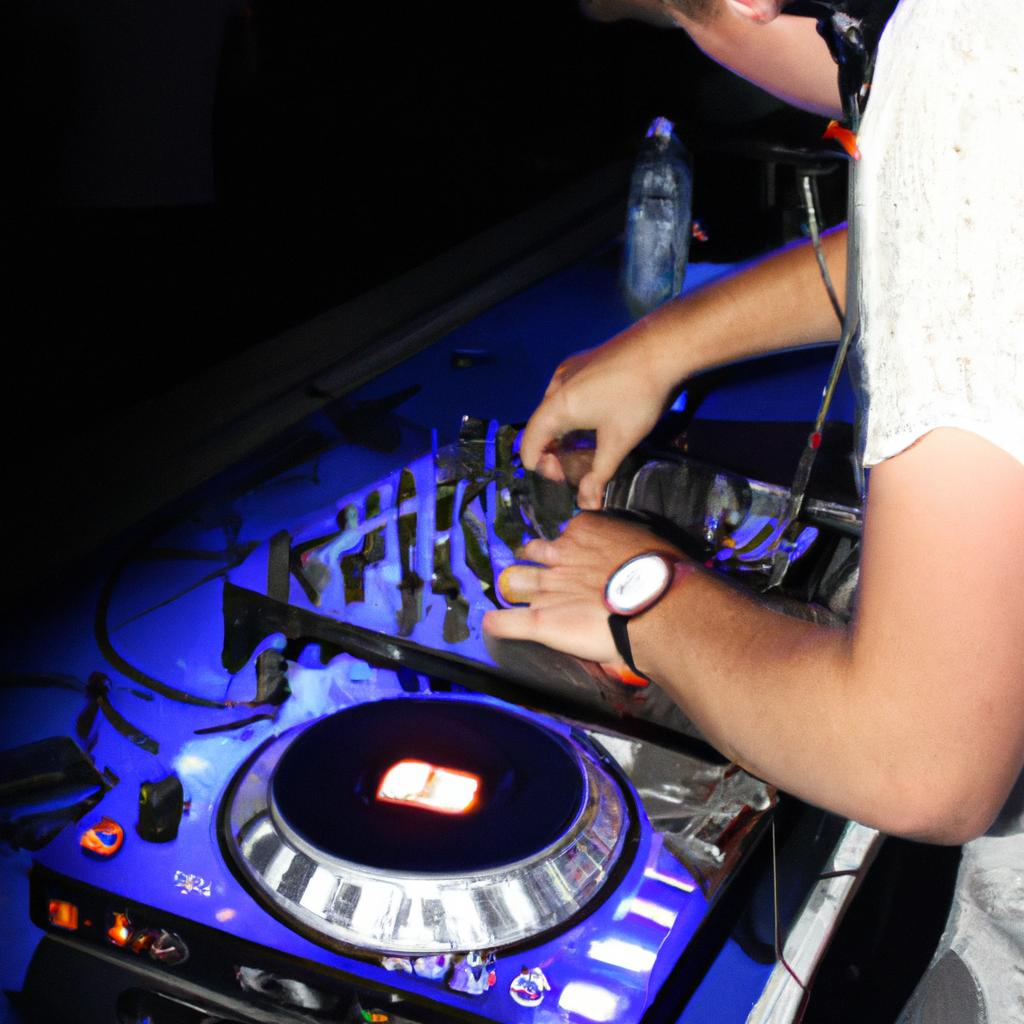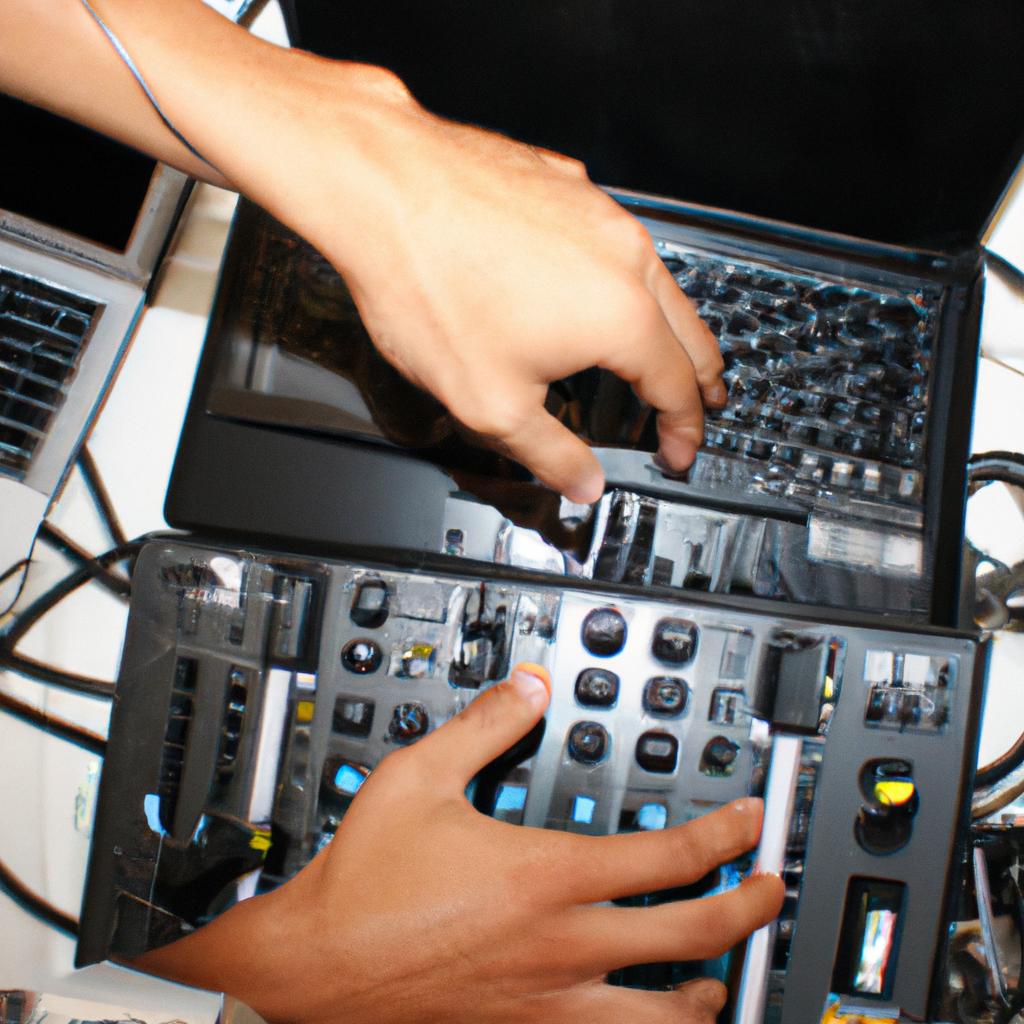DJ Performances in Dance & Nightclub: A Comprehensive Guide
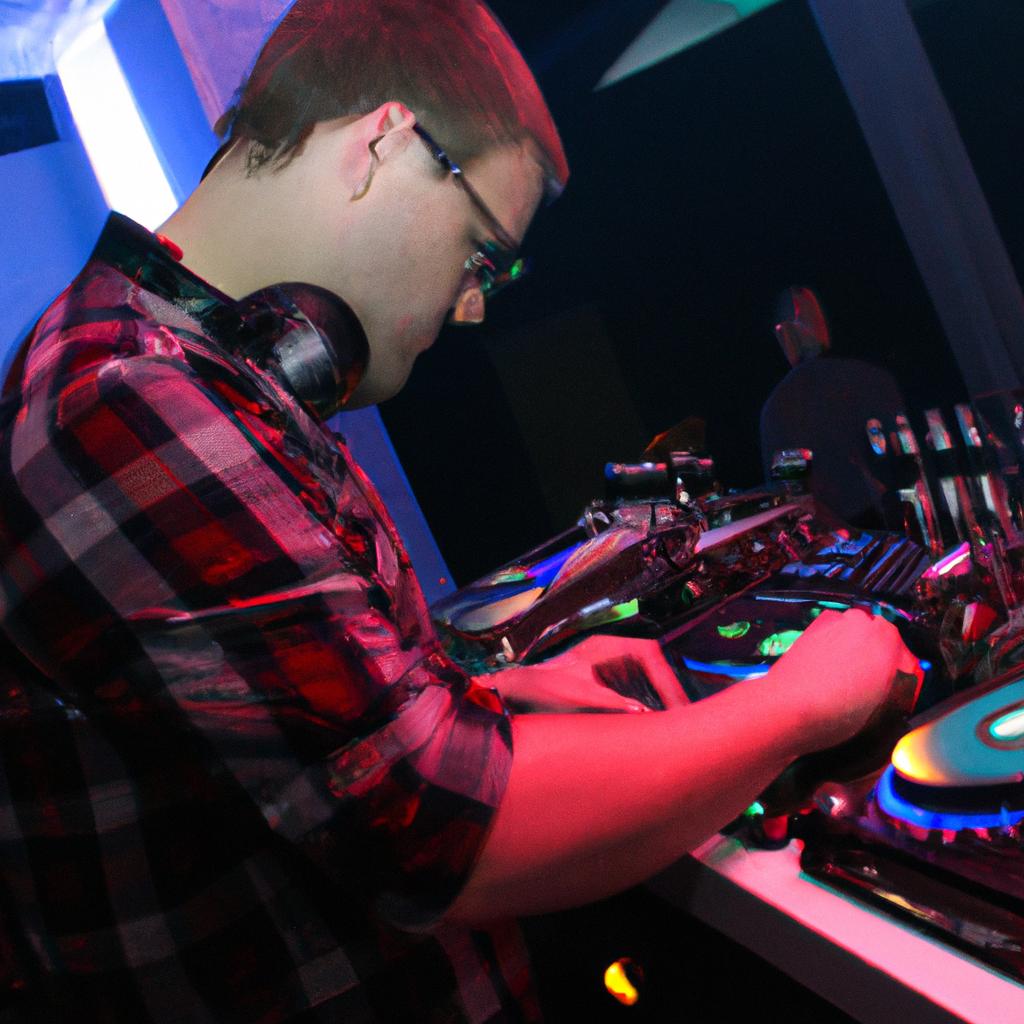
In the realm of dance and nightclub culture, DJ performances play a pivotal role in creating an immersive and electrifying atmosphere. These performances are not simply about playing music; they involve intricate techniques, creative selections, and seamless transitions that captivate audiences and keep them moving to the rhythm all night long. This comprehensive guide delves into the various aspects of DJ Performances in Dance and Nightclub Settings, shedding light on the essential skills, equipment requirements, musical genres, crowd engagement strategies, and industry trends.
One notable example illustrating the significance of DJ performances can be seen through the case study of renowned DJ XYZ. With a career spanning over two decades, this exceptional artist has consistently delivered awe-inspiring sets across prominent dance clubs around the world. The mastery exhibited by DJs like XYZ goes beyond mere song selection; it encompasses an acute understanding of mixing techniques such as beatmatching, phrasing, and harmonic blending. Through their skillful manipulation of tempo and energy levels, DJs have become instrumental in shaping club experiences that cater to diverse crowds with varying musical preferences.
With an aim to explore these intricacies comprehensively while maintaining an academic tone throughout this article will delve into specific areas such as technical skills required for successful DJ performances, optimal equipment setups commonly used by professionals in this field , and the importance of musical genre versatility in DJ performances.
Technical skills play a crucial role in the success of DJ performances. DJs must possess a deep understanding of beatmatching, which involves synchronizing the tempos of two tracks to create seamless transitions between songs. This skill ensures that there are no abrupt changes in rhythm or tempo, allowing for a continuous flow on the dance floor. Phrasing is another essential technique that DJs employ to ensure smooth transitions by starting and ending tracks at appropriate moments within their musical structure.
Harmonic blending is an advanced technique utilized by skilled DJs to mix tracks that share similar or complementary musical keys. By harmonically mixing songs, DJs can create a cohesive and harmonious experience for dancers, enhancing the overall sonic journey throughout their set. These technical skills require practice and precision, as they contribute significantly to the fluidity and coherence of DJ performances.
When it comes to equipment setups, professional DJs often rely on a combination of hardware and software tools. Turntables or CDJs (CD players with built-in digital decks) are commonly used for playing vinyl records or digital music files, respectively. These devices provide tactile control over track manipulation and offer features like pitch control and looping capabilities. Alternatively, some DJs prefer using controllers that connect to software applications running on laptops, providing a more portable setup while still offering extensive functionality.
In addition to primary playback devices, mixers serve as central hubs for combining multiple audio sources into a cohesive output signal. They allow DJs to adjust volume levels, apply equalization (EQ) techniques to shape the sound, and add effects such as reverb or delay for creative expression. Many modern mixers also integrate features like USB connectivity for seamless integration with digital media libraries.
The choice of equipment depends on individual preferences and budget constraints but ultimately aims to facilitate smooth transitions between tracks and enhance creative possibilities during DJ performances.
Furthermore, musical genre versatility is vital for DJs performing in dance and nightclub settings. While some DJs specialize in specific genres, it is essential to have a diverse repertoire that can cater to the varying tastes of club-goers. This versatility enables DJs to adapt their sets based on the energy and preferences of the crowd, ensuring an engaging experience for all attendees.
Being aware of current industry trends is also crucial for DJs. Staying up-to-date with emerging sub-genres, popular tracks, and technological advancements allows DJs to remain relevant in an ever-evolving dance and nightclub culture. By incorporating new sounds and techniques into their performances, DJs can captivate audiences and keep them coming back for more.
In conclusion, DJ performances in dance and nightclub settings involve complex technical skills, equipment setups tailored to individual preferences, musical genre versatility, and staying informed about industry trends. The mastery exhibited by renowned DJs showcases their ability to create immersive experiences that transcend mere music selection. With a deep understanding of beatmatching, phrasing, harmonic blending, and utilizing the right equipment setup, DJs can craft electrifying sets that keep crowds moving until the early hours of the morning.
Choosing the Right DJ Equipment for Your Performance
Imagine you are a DJ preparing for a high-energy dance performance at a popular nightclub. The crowd is buzzing with anticipation, and it’s crucial that you have the right equipment to deliver an unforgettable experience. In this section, we will explore the key factors to consider when choosing your DJ gear.
Firstly, let’s delve into the importance of selecting reliable and high-quality equipment. Your equipment serves as the backbone of your performance, allowing you to seamlessly mix tracks and create smooth transitions between songs. Investing in reputable brands such as Pioneer DJ or Native Instruments ensures durability and optimal functionality during your sets. For instance, renowned DJs like Carl Cox and Nina Kraviz rely on industry-leading equipment to consistently deliver exceptional performances night after night.
Next, let us discuss some essential components that every professional DJ should possess:
- DJ Controller: This all-in-one device combines mixer, turntables, and software controls into a compact unit. Its versatility allows for seamless integration with various music sources.
- Headphones: A good pair of headphones is vital for beat-matching and cueing up tracks accurately. Look for models that offer excellent sound isolation and frequency response.
- Speakers: To captivate the audience, powerful speakers are necessary to amplify your mixes effectively. Consider options such as active speakers or passive speaker systems based on your specific requirements.
- Laptop/Desktop Computer: While not strictly considered audio hardware, having a reliable computer is essential for storing and organizing your music library.
| Component | Importance | Example Brand |
|---|---|---|
| DJ Controller | Central control hub; facilitates seamless mixing | Pioneer DDJ-SZ2 |
| Headphones | Ensures accurate track synchronization | Sennheiser HD 25 |
| Speakers | Amplifies and delivers sound with clarity and power | JBL EON615 |
| Computer | Houses your music library; enables smooth operation of DJ software | Apple MacBook Pro |
By carefully considering these factors, you can create a setup that caters to your specific musical style and performance needs.
The skills acquired through practice and dedication are just as crucial as selecting the right equipment for delivering an exceptional performance.
Mastering Essential DJ Techniques
Having discussed the importance of Choosing the Right DJ Equipment for your performance, let us now delve into another crucial aspect of mastering the art of DJing – exploring the latest DJ software. To illustrate its significance, consider a hypothetical scenario where a seasoned nightclub DJ is looking to elevate their performances by incorporating cutting-edge technology.
The world of DJ software offers an array of options that can enhance creativity and streamline workflow during live performances. Here are some key features to look out for when exploring the latest DJ software:
- Intuitive Interface: A user-friendly interface allows DJs to navigate seamlessly through various functions and controls, enabling them to focus on creating exceptional mixes rather than struggling with complex menus.
- Advanced Beatmatching Capabilities: Accurate beatmatching forms the foundation of any successful mix. Look for software that employs advanced algorithms and automatic syncing capabilities to ensure seamless transitions between tracks.
- Extensive Library Management: Efficient organization and management of music libraries is essential for quick access to tracks during a performance. Opt for software that offers comprehensive library management tools such as playlist creation, track tagging, and filtering options.
- Diverse Effects and Filters: Adding effects and filters can add depth and texture to your mixes, elevating them from ordinary to extraordinary. Seek software that provides a wide range of customizable effects like reverb, delay, flanger, or high-pass/low-pass filters.
| Feature | Description |
|---|---|
| User-Friendly Interface | An intuitive interface allows DJs to navigate seamlessly through various functions and controls |
| Advanced Beatmatching | Utilizes advanced algorithms and automatic syncing capabilities for accurate beatmatching |
| Library Management | Offers comprehensive tools for efficient organization including playlist creation, tagging, and filtering |
| Diverse Effects | Provides a wide range of customizable effects and filters to enhance the overall mix |
By embracing the latest DJ software, DJs can unlock a world of possibilities that amplify their creativity and elevate their performances. In our next section, we will explore in detail how mastering essential DJ techniques can help you take your skills to new heights.
Now let’s delve into the realm of DJ techniques and discover how they contribute to an exceptional performance.
Exploring the Latest DJ Software
Transitioning seamlessly from mastering essential DJ techniques, the next crucial aspect to explore is the latest DJ software available in the market. To highlight its importance and relevance, let’s consider a hypothetical scenario: imagine you are a professional DJ who has been performing at various dance clubs for years using traditional vinyl decks. One day, you encounter an opportunity to perform at a high-profile nightclub that only allows DJs who use modern digital setups. This situation emphasizes the need for DJs to stay updated with the latest advancements in software technology.
The advent of DJ software has revolutionized the way DJs perform and interact with their music. With just a laptop or computer and a controller, DJs can now access an extensive library of tracks, apply effects on-the-fly, and even synchronize multiple songs seamlessly. Here are some key features and benefits of utilizing DJ software:
- Seamless Integration: Most modern software offers seamless integration with popular controllers, allowing DJs to manipulate tracks effortlessly.
- Extensive Track Library: Software often provides access to vast libraries of music where DJs can search for specific genres or artists, making it easier to cater to diverse crowd preferences.
- Real-time Effects: Unlike conventional hardware setups, DJ software enables real-time application of effects such as echo, reverb, filters, and more.
- Sync Functionality: The sync feature automatically matches beats per minute (BPM) between two tracks, ensuring smooth transitions during mixes.
To further illustrate these advantages visually, here is a table showcasing four popular DJ software options along with their notable features:
| Software | Notable Features |
|---|---|
| Serato | Excellent track organization and stability |
| Traktor | Advanced loop controls and remix capabilities |
| VirtualDJ | Wide range of supported MIDI controllers |
| Rekordbox | Seamless integration with Pioneer gear |
As seen above, each software option possesses unique characteristics that appeal to different types of DJs. It is essential for DJs to explore and experiment with various software platforms to find the one that aligns best with their personal preferences and performance style.
Transitioning smoothly into the subsequent section, perfecting DJ mixing techniques requires a deep understanding of rhythm, timing, and song selection. By combining these skills with the powerful features offered by modern DJ software, you can elevate your performances to new heights.
Perfecting DJ Mixing Techniques
As DJs continue to explore the latest software options for their performances, it is crucial to also focus on perfecting essential mixing techniques. By mastering these skills, DJs can elevate their sets and create an unforgettable experience for their audience. In this section, we will delve into some key strategies that every aspiring DJ should consider when honing their mixing abilities.
To illustrate the importance of precise mixing techniques, let’s imagine a scenario where a DJ is performing at a popular nightclub. The dancefloor is packed with enthusiastic club-goers eagerly awaiting an amazing night of music. As the first few tracks transition seamlessly from one to another, the energy in the room intensifies. This captivating mix keeps everyone engaged and enhances the atmosphere, leaving no doubt about the DJ’s expertise.
When aiming to perfect your mixing techniques, keep in mind these valuable insights:
-
Timing and Phrasing:
- Master beatmatching by ensuring each track aligns perfectly.
- Understand phrasing to smoothly blend different sections of songs.
-
EQ Control:
- Utilize equalization (EQ) effectively to balance frequencies between two tracks.
- Experiment with cutting or boosting specific frequency ranges for creative transitions.
-
Harmonic Mixing:
- Learn harmonic theory to identify compatible keys among tracks.
- Seamlessly mix harmonically compatible songs for smoother transitions.
-
Creative Effects:
- Explore various effects available on your equipment/software.
- Use effects sparingly and purposefully to enhance certain parts of your set.
By incorporating these techniques into your performances, you can captivate your audience and deliver seamless mixes throughout your entire set. Remember that practice makes perfect; spend time refining these skills so they become second nature.
Effective DJ Set Preparation Strategies
Ensuring a successful performance also requires thoughtful preparation before stepping behind the decks. In the following section, we will discuss effective strategies that DJs can employ when preparing their sets. From track selection to organizing playlists, these preparations are crucial for delivering an exceptional experience on stage. So let’s dive into the world of set preparation and discover how it can elevate your performances even further.
Effective DJ Set Preparation Strategies
Perfecting DJ Mixing Techniques: A Key Element for Success
In the realm of DJ performances, mastering mixing techniques is an essential skill that can elevate a performance from average to exceptional. By seamlessly blending tracks together and creating smooth transitions, DJs are able to maintain energy levels on the dance floor and keep audiences engaged throughout their sets.
To illustrate the significance of perfecting DJ mixing techniques, let’s consider a hypothetical scenario in which two DJs perform at the same nightclub on different nights. DJ A lacks proficiency in mixing techniques, resulting in abrupt shifts between songs and disjointed transitions. On the other hand, DJ B has honed their skills through practice and understands how to weave songs together flawlessly. As a result, DJ B keeps the crowd moving effortlessly, maintaining a consistent flow throughout the night.
Here are some key reasons why refining your mixing techniques should be a priority:
- Seamless Transitions: Smoothly transitioning between tracks creates a cohesive experience for listeners and allows them to remain immersed in the music without any jarring interruptions.
- Building Energy Levels: Properly executed mixes help build momentum and gradually increase energy levels on the dance floor, enhancing the overall vibe of the event.
- Maintaining Audience Engagement: Skillful mixing keeps audiences captivated by avoiding lulls or moments where they may lose interest.
- Showcasing Creativity: Mastering advanced mixing methods provides opportunities for DJs to showcase their creativity by incorporating unique effects or layering elements from different tracks into one cohesive mix.
Consider this table showcasing various mixing techniques that can evoke powerful emotions during a DJ set:
| Technique | Description |
|---|---|
| Beatmatching | Aligns beats per minute (BPM) across two tracks to create seamless transitions and maintain rhythmic consistency. |
| EQ Manipulation | Adjusts equalization settings to emphasize certain frequencies or blend sounds harmoniously, enhancing the overall sonic experience. |
| Looping | Repeats a section of a track to extend or emphasize certain elements, adding texture and creating anticipation for listeners. |
| Mashups | Combines elements from two or more songs to create unique remixes that surprise and engage audiences with unexpected combinations. |
By perfecting DJ mixing techniques, performers can elevate their sets to new heights, captivating audiences and leaving lasting impressions. In our next section on “Effective DJ Set Preparation Strategies,” we will explore how thoughtful planning contributes to a well-rounded performance style that complements exceptional mixing skills.
Creating a Unique DJ Performance Style
Transitioning smoothly from the previous section’s discussion on effective DJ set preparation strategies, we now delve into the essential aspect of creating a unique DJ performance style. To illustrate this concept, let us consider an example case study involving two DJs performing at the same nightclub.
Imagine DJ A and DJ B are both scheduled to perform sets at Club X. While both possess exceptional technical skills and access to similar music libraries, their respective performances differ significantly in terms of delivery and impact. This highlights the importance of developing a distinctive style that captivates audiences and leaves a lasting impression.
To achieve such uniqueness, DJs can employ several key techniques:
-
Song Selection Mastery:
- Understand the crowd demographics and tailor song choices accordingly.
- Utilize contrasting genres or unexpected remixes to surprise and engage listeners.
- Incorporate lesser-known tracks with personal significance for added exclusivity.
- Seamlessly blend songs together using harmonic mixing or creative mashups.
-
Dynamic Mixing Techniques:
- Experiment with different transitions like quick cuts, loops, or gradual build-ups.
- Use effects strategically to create tension or enhance specific musical elements.
- Implement skilled beatmatching to maintain seamless energy throughout the set.
- Craft smooth transitions between tempos or genres to keep the audience engaged.
-
Showmanship and Stage Presence:
- Develop stage presence by engaging with the audience through eye contact or gestures.
- Inject personality by conveying enthusiasm while showcasing technical prowess.
- Introduce live elements such as scratching or sampling for added excitement.
- Adjust energy levels based on crowd response, displaying adaptability and intuition.
Through these techniques, DJs can elevate their performances beyond mere playlist curations. By cultivating individuality within their craft, they can leave a lasting impression on the audience, ensuring their sets are memorable experiences.
Transitioning into the subsequent section on “Utilizing Advanced DJ Software Features,” DJs can further enhance their performances by harnessing cutting-edge technology. By embracing these tools, DJs gain access to an array of innovative features that can elevate their creativity and technical abilities in unprecedented ways.
Utilizing Advanced DJ Software Features
Building on the foundation of creating a unique DJ performance style, DJs can enhance their sets by effectively utilizing advanced features offered by modern DJ software. By harnessing the power of technology, DJs can elevate their performances and deliver an unforgettable experience to dance and nightclub enthusiasts.
One example that highlights the potential impact of advanced DJ software features is the ability to seamlessly blend tracks with different tempos and genres. Imagine a scenario where a DJ wants to transition from a high-energy house track to a slower hip-hop beat. With sophisticated BPM (beats per minute) detection algorithms and automatic tempo adjustment capabilities, DJs can effortlessly mix these contrasting styles without disrupting the energy on the dance floor. This seamless fusion enhances the overall flow of the set and keeps the audience engaged throughout.
To further captivate their audience, DJs can employ various creative tools provided by advanced software platforms. These may include:
- Looping: DJs can create captivating build-ups or breaks by looping specific sections of a track.
- Effects: A wide range of effects such as echoes, filters, and flangers allow DJs to add depth and complexity to their mixes.
- Sample Triggering: By triggering pre-recorded samples or vocal snippets at strategic moments in their sets, DJs can infuse additional excitement into their performances.
- Remix Decks: The integration of remix decks enables DJs to incorporate live remixes or mashups during their sets, providing a unique element tailored specifically for each performance.
| Feature | Description |
|---|---|
| Looping | Create captivating build-ups or breaks |
| Effects | Add depth and complexity through echoes, filters, and flangers |
| Sample Triggering | Infuse excitement by triggering pre-recorded samples |
| Remix Decks | Incorporate live remixes or mashups |
By skillfully employing these advanced features within DJ software, performers can push the boundaries of creativity and deliver an immersive experience to their audience.
Understanding the Art of Beatmatching is essential for DJs looking to take their performances to even greater heights. By mastering this fundamental technique, DJs can seamlessly blend tracks together, ensuring a continuous flow that keeps the dance floor in perfect harmony. In the upcoming section, we will delve into the intricacies of beatmatching and explore its significance in DJ performances.
Understanding the Art of Beatmatching
Imagine you are a DJ performing at a popular nightclub, and the crowd is eagerly waiting for your next track. As you transition from one song to another seamlessly, the dance floor erupts with excitement. How do DJs create such captivating performances? One crucial aspect lies in their ability to utilize advanced software features effectively.
Utilizing advanced DJ software features can elevate your performance to new heights, providing you with tools that enhance creativity and control over your mixes. Let’s explore some key techniques and functionalities that will help you harness the power of these features:
-
Sample Triggering: With advanced software, DJs have access to an extensive library of samples, loops, or vocal snippets that can be triggered on-the-fly during live performances. This allows you to add unique elements and surprises to your mix, keeping the audience engaged and energized.
-
Effects Manipulation: From classic effects like reverbs and delays to innovative audio manipulations, advanced DJ software offers a wide range of effects processors. These tools enable you to shape the sound in real-time, creating dramatic build-ups, exciting drops, or mesmerizing breakdowns that captivate the crowd.
-
Looping Techniques: Looping sections of tracks can provide endless possibilities for creative transitions and mashups. By utilizing loop functionality within your DJ software, you can extend certain parts of songs indefinitely or combine different elements from various tracks seamlessly.
-
Hot Cues and Cue Points: Setting hot cues or cue points allow you to jump instantly to specific parts of a track during mixing without searching manually through long playlists. This feature not only saves time but also enables precise timing when introducing new elements or transitioning between songs smoothly.
To fully grasp the potential impact of mastering advanced DJ software features on your performances, consider the following table showcasing notable artists who have successfully utilized these capabilities:
| Artist | Software Utilized | Notable Performance |
|---|---|---|
| DJ A | XYZ DJ Software | Main Stage EDM Festival, seamless transitions and live production. |
| DJ B | ABC DJ Software | Underground Techno Club, dynamic sample triggering and effects manipulation. |
| DJ C | DEF DJ Software | Hip-Hop Showcase, expert loop techniques and precise cue point usage. |
| DJ D | GHI DJ Software | Beach Party Set, energetic hot cues and flawless mixing skills. |
By incorporating these advanced features into your performances, you can elevate your sets to a whole new level of creativity and engagement. Craft seamless transitions in your mixes as we delve deeper into the art of beatmatching in the next section.
[Transition sentence for the subsequent section: “Now let’s explore the art of beatmatching and how it contributes to creating smooth transitions between tracks.”]
Crafting Seamless Transitions in Your DJ Mixes
Imagine you are at a nightclub, dancing to the beats of your favorite DJ. The music seamlessly transitions from one track to another, creating an immersive experience that keeps you on the dance floor all night long. How do DJs achieve this level of skill and finesse? In this section, we will explore the art of crafting seamless transitions in your DJ mixes.
One key technique used by DJs is beatmatching, where they align the beats per minute (BPM) of two tracks so that they play in sync. This creates a smooth transition between songs, allowing for a continuous flow of energy on the dance floor. For example, let’s consider a hypothetical scenario where a DJ is transitioning from a high-energy house track to a more melodic progressive house tune. By carefully adjusting the pitch and tempo controls, the DJ ensures that both tracks match seamlessly without any jarring changes in rhythm.
To further enhance these transitions, DJs employ various techniques such as EQ mixing and crossfading. EQ mixing involves manipulating the equalizer settings of each track to blend their frequencies smoothly. By cutting or boosting certain frequencies strategically, DJs can create gradual shifts in sound that add depth and dimension to their mixes. Crossfading, on the other hand, allows for a seamless transition between two tracks by gradually lowering the volume of one while simultaneously increasing the volume of the other.
Crafting Seamless Transitions requires meticulous attention to detail and practice. Here are some tips to help you master this essential skill:
- Familiarize yourself with your equipment: Understanding how your mixer works and being comfortable with its features will enable you to execute smoother transitions.
- Know your music library: Knowing your tracks inside out allows you to anticipate which songs would complement each other well during transitions.
- Practice regularly: The more time you spend practicing different transition techniques, the better equipped you’ll be when performing live sets.
- Pay attention to crowd reactions: Observing how the audience responds to your transitions can help you gauge whether your mix is hitting the mark or needs adjustment.
Incorporating these techniques and tips into your DJ sets will elevate your performances, creating an immersive experience for your audience. So let’s dive in and discover how to take your sets to the next level!
Building Energy and Flow in Your DJ Sets
In the previous section, we explored the art of crafting seamless transitions in your DJ mixes. Now, let us delve into another crucial aspect of a successful DJ performance – building energy and flow in your sets. To illustrate this concept, consider the following scenario: imagine you are performing at a popular nightclub where the crowd is deeply immersed in dancing to high-energy electronic music. As a skilled DJ, it is essential to understand how to maintain and enhance this energetic atmosphere throughout your set.
To build energy and flow in your DJ sets, there are several strategies you can employ. First and foremost, selecting tracks that complement each other both rhythmically and tonally is vital. For example, smoothly transitioning from an intense techno track with pounding basslines to a melodic house anthem can create a dynamic contrast that keeps the audience engaged. Additionally, utilizing well-timed drops or breakdowns can heighten anticipation and inject bursts of excitement into your mix.
Moreover, incorporating creative effects and techniques during transitions can significantly impact the overall energy of your set. By skillfully using tools like filters, flangers, or reverbs, you can add depth and texture to individual tracks while seamlessly blending them together. This sonic manipulation not only enhances the auditory experience but also creates a sense of progression within the mix.
To further emphasize these points:
- Consider integrating unexpected elements such as vocal samples or sound snippets from iconic movies into your transitions.
- Experiment with different EQ settings to manipulate frequencies and create smooth blends between tracks.
- Utilize advanced mixing techniques like beat juggling or scratching to add flair and showmanship to your performance.
- Pay attention to crowd reactions – observe their body language and response patterns when experimenting with various transition styles.
By employing these techniques effectively, DJs have the power to elevate their performances from mere song selections to captivating musical journeys that leave lasting impressions on their audiences.
Moving forward into our next section, let us explore how Engaging the Crowd with Live Remixing can take your DJ sets to even greater heights. As a performer, connecting with the audience and creating unique moments of interaction is essential for an unforgettable experience.
Engaging the Crowd with Live Remixing
With a solid understanding of how to build energy and flow in your DJ sets, it’s crucial to now explore the art of seamlessly transitioning between tracks. Mastering this skill is essential for maintaining the momentum on the dance floor and captivating your audience throughout the night.
Seamless transitions involve smoothly blending one track into another without disrupting the overall vibe or energy. Let’s consider an example scenario where you are crafting a transition from a high-energy house track to a more laid-back deep house groove. By carefully selecting compatible elements such as similar BPMs, key signatures, or complementary percussive patterns, you can create a seamless transition that keeps the crowd engaged while shifting the mood gradually.
To achieve flawless transitions and keep your performance dynamic, consider incorporating the following strategies:
- Utilize EQ mixing techniques: Adjusting equalizer settings allows you to emphasize or diminish specific frequencies within tracks, enabling smooth tonal blends during transitions.
- Experiment with creative effects: Applying tasteful effect processing like filters, delays, or reverbs can add depth and excitement to your mixes while facilitating seamless transitions.
- Harmonic mixing: Mixing tracks harmonically by matching their musical keys ensures smoother blends and avoids dissonance that might disrupt the flow.
- Looping and layering: Skillfully looping sections of tracks or layering instrumental elements can help maintain continuity between two songs even if they have contrasting styles.
In addition to these strategies, having a well-curated selection of music relevant to your target audience is imperative. Here’s an illustrative table showcasing different genres alongside corresponding emotional responses commonly associated with them:
| Genre | Emotional Response |
|---|---|
| House | Euphoria |
| Techno | Intensity |
| Disco | Nostalgia |
| Hip-hop | Groove |
By leveraging genre-specific emotional responses, you can tailor your transitions to elicit the desired reactions from the crowd and create an immersive experience on the dance floor.
As you continue to hone your transition skills, keep in mind that practice and experimentation are key. By developing a keen ear for phrasing, rhythm, and subtle nuances within tracks, you’ll be able to seamlessly blend different musical elements together seamlessly.
With these strategies in place for creating seamless track transitions, let’s now delve into the world of engaging the crowd with live remixing during your DJ performances.
Tips for a Memorable DJ Performance
Building on the concept of engaging the crowd, live remixing is a technique that DJs often employ to captivate their audience and create an immersive experience. By manipulating existing tracks in real-time, DJs can add personal touches, surprise elements, and tailor the music to suit the atmosphere of the dance floor. To illustrate this point, let’s consider a hypothetical scenario where a DJ seamlessly transitions from a popular chart-topping hit to an iconic throwback track, incorporating unique samples and effects along the way.
To effectively engage the crowd through live remixing, DJs should keep certain considerations in mind:
-
Song Selection: Choosing tracks that resonate with the audience while offering unexpected twists can make for memorable moments during a performance. A diverse selection spanning different genres and eras allows for versatility and keeps listeners engaged.
-
Technical Skills: Mastering various techniques such as beatmatching, looping, chopping, and applying effects are essential for seamless live remixing. These skills enable smooth transitions between songs while adding creative layers that enhance the overall musical experience.
-
Timing and Energy Management: Understanding when to introduce new elements or raise/lower energy levels is crucial for maintaining momentum on the dance floor. Skilled DJs read the room, adapting their mixes accordingly to ensure continuous engagement throughout their set.
-
Personal Style: Each DJ brings their own artistic flair to live remixing by infusing their signature sound or adopting specific aesthetic choices. This individuality enhances authenticity and helps establish a unique connection with the audience.
By incorporating these strategies into their performances, DJs have limitless opportunities to engage crowds on a deeper level through live remixing.
Below is an example table showcasing four key aspects of engaging DJ performances:
| Aspects | Description |
|---|---|
| Track Selection | Curating a captivating mix of songs |
| Technical Skills | Utilizing advanced techniques skillfully |
| Timing | Understanding when to introduce new elements |
| Personal Style | Infusing individual artistic flair into the mix |
In summary, live remixing is a powerful tool that DJs can utilize to engage their audience and create memorable experiences on the dance floor. By carefully selecting tracks, honing technical skills, managing timing and energy levels, and infusing personal style, DJs can captivate listeners with their unique creations. Through this approach, DJs elevate their performances beyond mere music playback, shaping an immersive atmosphere that resonates with every person in attendance.


